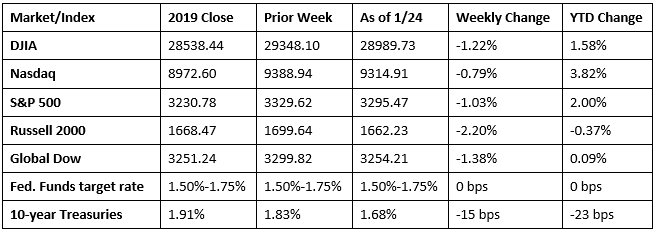Last week proved to be a tough one for the market as each of the benchmark indexes listed here lost value. Concern over the possible spread of the coronavirus from China apparently provided the impetus for investors to pull away from stocks. Long-term bond prices soared, pushing yields 15 basis points lower. The price of gold also climbed after falling the week prior. The small caps of the Russell 2000 were hit the hardest, down over 2.0% for the week, which pushed that index below its 2019 closing value. The Global Dow, Dow, and S&P 500 each lost more than 1.0%, while the tech-heavy Nasdaq dropped over three-quarters of a percent.
Oil prices plummeted last week, closing at $54.21 per barrel by late Friday afternoon, down from the prior week’s price of $58.73. The price of gold (COMEX) jumped higher last week, closing at $1,570.70 by late Friday afternoon, up from the prior week’s price of $1,556.80. The national average retail regular gasoline price was $2.537 per gallon on January 20, 2020, $0.033 lower than the prior week’s price but $0.286 more than a year ago.
Last Week’s Economic News
- After falling in November, sales of existing homes advanced in December, climbing 3.6% ahead of November’s totals. Existing home sales finished 2019 at about the same level as in 2018. The median sales price for all housing types in December was $274,500, 7.8% above the December 2018 median sales price ($254,700). Unsold inventory sits at a 3.0-month supply at the current sales pace, down from the 3.7-month figure recorded in November. Sales of existing single-family homes in December were 2.7% greater than sales in November and 10.6% ahead of December 2018. The median sales price for existing single-family homes was $276,900 in December, up 8.0% from the previous December. Consumer prices rose 0.2% in December following a 0.3% jump in November. Over the last 12 months, consumer prices have increased 2.3%, the largest 12-month increase since the period ended October 2018. Driving the monthly price increase was a 2.8% hike in gasoline prices (up 7.9% since December 2018). Consumer prices less food and energy crept up 0.1% last month and are up 2.3% over the last 12 months.
- For the week ended January 18, there were 211,000 claims for unemployment insurance, an increase of 6,000 from the previous week’s level, which was revised up by 1,000. According to the Department of Labor, the advance rate for insured unemployment claims remained at 1.2% for the week ended January 11. The advance number of those receiving unemployment insurance benefits during the week ended January 11 was 1,731,000, a decrease of 37,000 from the prior week’s level, which was revised up by 1,000. Consumers ramped up their purchases at the retail level in December as sales increased by 0.3% from November’s total. Retail sales are up 5.8% over December 2018, and total sales for 2019 are 3.6% ahead of sales for the previous year. Retail trade sales (resales of consumer items) were up 0.4% from November 2019 and 6.0% above last year. Nonstore (online) retail sales were up 19.2% from December 2018, and gasoline station sales were up 11.3% from last year.

Chart reflects price changes, not total return. Because it does not include dividends or splits, it should not be used to benchmark performance of specific investments.
Eye on the Week Ahead
The last week of the month offers several important economic reports for December. Sales of new single-family homes have surged during the fourth quarter. November’s sales figures were robust and well ahead of the pace set in November 2018. Indicative of a waning manufacturing sector, new orders for durable goods were 1.3% lower through November 2019 compared to the previous year. December’s totals may provide a boost to that downward trend. The Federal Open Market Committee meets for the first time in 2020. Interest rates are not expected to be adjusted at this time. The first report on the gross domestic product for the fourth quarter is out this week. The third-quarter GDP advanced at an annualized rate of 2.1%.
The Week Ahead

The information provided is obtained from sources believed to be reliable. Forecasts cannot be guaranteed. Past performance is not a guarantee of future results.